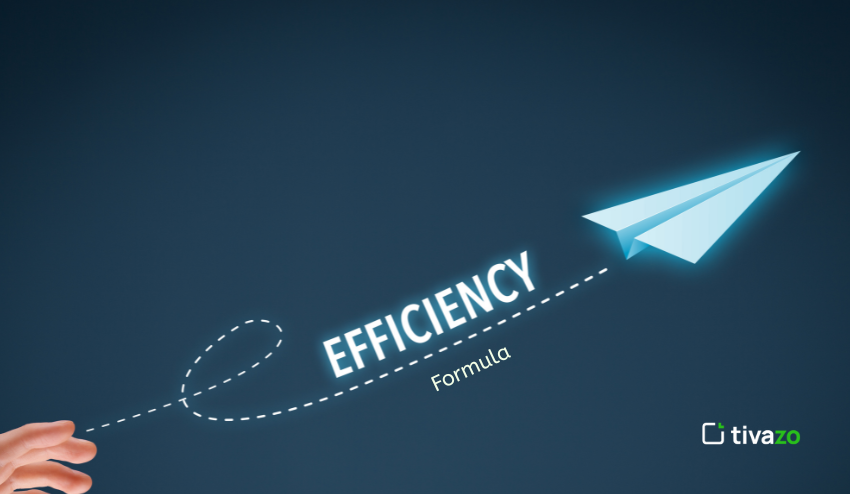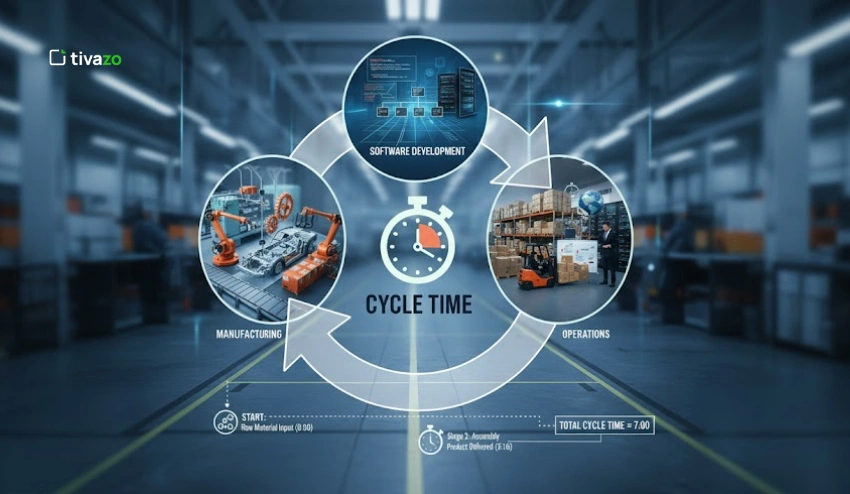Mastering the efficiency formula is important in today’s world of rapid change. But what is the efficiency formula? The efficiency formula is a measure of how the inputs are turned into outputs. In other words, getting the most out of something while using the least amount of wasted time or resources. When we master the efficiency formula, we teach people, organizations, and platforms like Tiivazo to perform better, yielding better results.
Key Highlights:
- Defining Efficiency
- Why Efficiency Matters
- Types of Efficiency & Related Efficiency Formula Variants
- What is the formula for efficiency?
- Differences between Efficiency and Productivity
- How do you calculate work efficiency?t
- Is 100% Efficiency Attainable?
Whether it’s understanding how much energy is lost in a machine, understanding how productive an employee is, or understanding how efficiently a business process is providing outputs, the efficiency formula is a standard concept. The efficiency formula is effective for businesses to eliminate bottlenecks, refine processes, and determine how well they are using their resources. The efficiency formula is also important in a learning institution for students studying for GCSE, or the importance of efficiency in the world of work, allowing students to draw obvious conclusions or even solve real productivity problems in the physical world.
More importantly, organizations that truly value making decisions from data, like Tiivazo, can embed the efficiency formula as a third-party or web app member of the team, building this efficiency tool into the dashboards, reports, and analytics to create a more powerful experience for their audience users. This converts raw data into insights, and if it could convert parts of the wider organizational usage of its data into insights, the efficiency formula could do so much more than just calculation; it could be a game-changer.
In the end, mastering is really about achieving growth, saving time, and getting more done with less! Surely, that is something every person, every institution, and every business could hope to have achieved, in 2025 and always.
Defining Efficiency
The concept of efficiency refers to producing maximum output with minimum input. The efficiency equation quantifies efficiency and is generally written as follows:
Efficiency = Useful Output/Total Input × 100 %
You will see this efficiency equation in business, energy, production, and other areas, to convey putting things into a better-performing and less wasteful environment.
In other words, in simpler terms, efficiency is doing more with less. A machine uses less energy, a business spends less money, or a team has less time and works fewer hours to produce greater results. The efficiency equation can demonstrate the efficiency of how well resources are used. It is not only about speed or volume. It looks at the aspects of quality, sustainability, and optimization. When organizations apply the efficiency assessment repeatedly, they gain an understanding of operational performance, which leads to making operations streamlined, removing waste, and creating opportunities for profitability. In today’s environment, where competition is fierce, becoming more efficient is no longer a choice or a significant part of long-term growth and opportunity for success.
Why Efficiency Matters
Using the efficiency equation allows businesses to conserve costs, make more money, and conserve production resources. It is also a method for the organization to measure where resources like time, money, and energy that are used as inputs can be wasted and to make informed decisions for any adjustments. Moreover, by continually measuring efficiency, teams will create opportunities to streamline performance and remove year-end overhead costs, and productivity will increase with little further input required, thus leading to a better bottom line!
Types of Efficiency & Related Efficiency Formula Variants
1. Operational efficiency
Operational efficiency is the expression for output per unit of cost or used resource. Here, the efficiency formula is slightly changed to reflect:
Operational Efficiency = Output/Input or Revenue/Operating Cost2. Allocative & economic efficiency
Economic, or allocative efficiency, uses the efficiency formula to determine the optimal allocation of a resource between uses. Because of this, it is generally a combination of a marginal cost‐benefit analysis, which also follows the efficiency principle.
3. Peak efficiency
Peak, or maximum efficiency, applies when all resources are being used, in prescribed conditions. The typical efficiency formula is then:
Peak Efficiency = Actual Output / Maximum Possible Output × 100%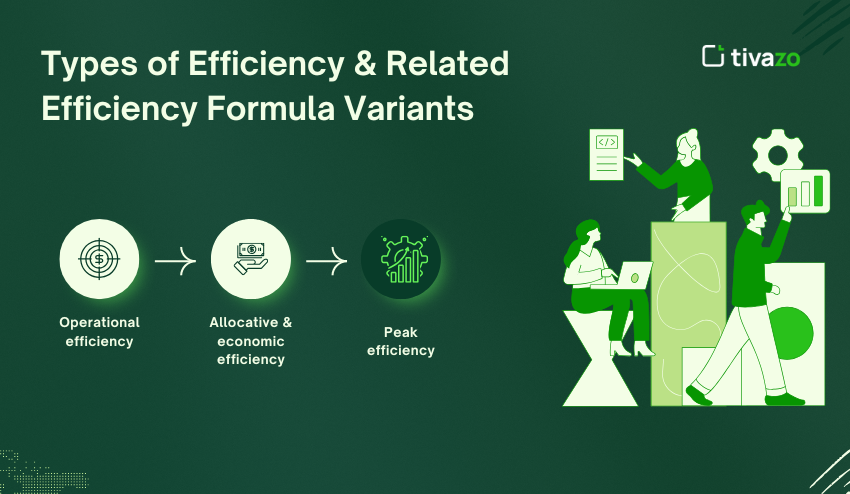
What is the formula for efficiency?
These are the most common variations of efficiency formulas:
1. The basic efficiency formula
Efficiency = Useful Output / Total Input × 100%
2. GCSE-style production efficiency
In GCSE exams, students likely learn:
Efficiency GCSE = Output Rate / Standard Output Rate × 100%This GCSE efficiency formula is how we can measure how production is operating against a set of standard rates (e.g., a theoretical maximum).
3. Bank efficiency ratio formula
Banks use:
Efficiency Ratio = Non‑interest Expenses / Revenue × 100%A lower ratio (often ≤50%) means a higher efficiency.
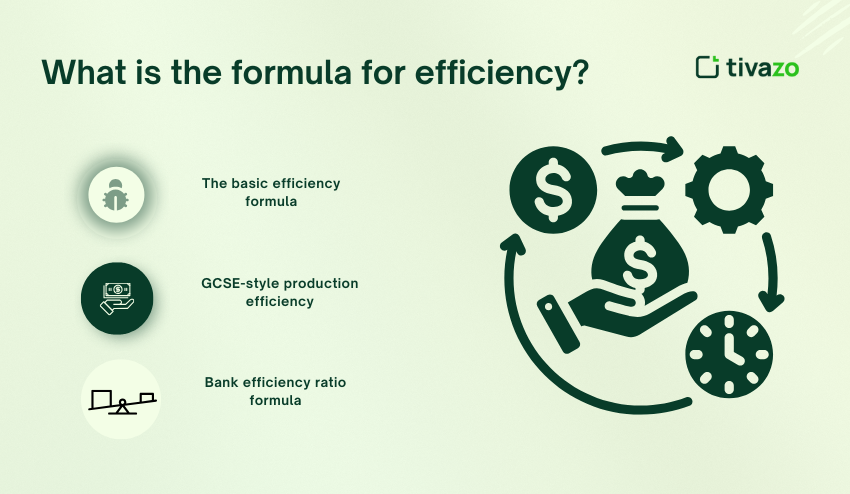
Differences between Efficiency and Productivity
Productivity measures output per unit input (for example, units produced per hour).
Efficiency (calculated with the efficiency formula) considers the optimal use of inputs, minimizing waste, and ensuring quality.
In the examples below, there is high productivity and an inefficient process, meaning that there is a lot of output, but with a lot of waste. There is high efficiency, meaning there was smart production and it was leaner than the first example.
Key Differences
Examples of real-world scenarios demonstrating the differences:
| Scenario | Productivity | Efficiency | Explanation |
| 1. Manufacturing Factory A | Produces 1000 units a day | Excessive use of raw material with 20% waste | High productivity, but low efficiency because of the waste of the raw material |
| 2. Call Center Agent | Handles 50 calls a day. | Resolves 80% of the issues at the first call | High efficiency (the outcomes were effective), average productivity |
| 3. Delivery Driver | Delivers 100 packages a day | Takes the longest route and burns more fuel to deliver the packages | Productive, but the costly and inefficient routing |
| 4. Software Developer | Writes 500 lines of code a day | Producing a lot of bugs with a lot of rework | High productivity, but very low efficiency because of quality issues |
| 5. Restaurant Kitchen Serves | 300 meals a night | Their food waste is minimal, with a highly optimized staff to reduce costs | High efficiency, based on balanced productivity |
Using the efficiency formula listed above, alongside productivity measures like those you see above, tells a more complete story when it comes to measuring performance.
Formula & examples
Productivity formula:
Productivity = Output / Input Efficiency formula:
Efficiency = Actual Output / Best Possible Output × 100 %
Example table:
| Metric | Formula | Interpretation |
| Productivity | Output ÷ Input | Measures volume produced per resource |
| Efficiency | (Actual ÷ Best) × 100% | Measures optimality relative to the benchmark |
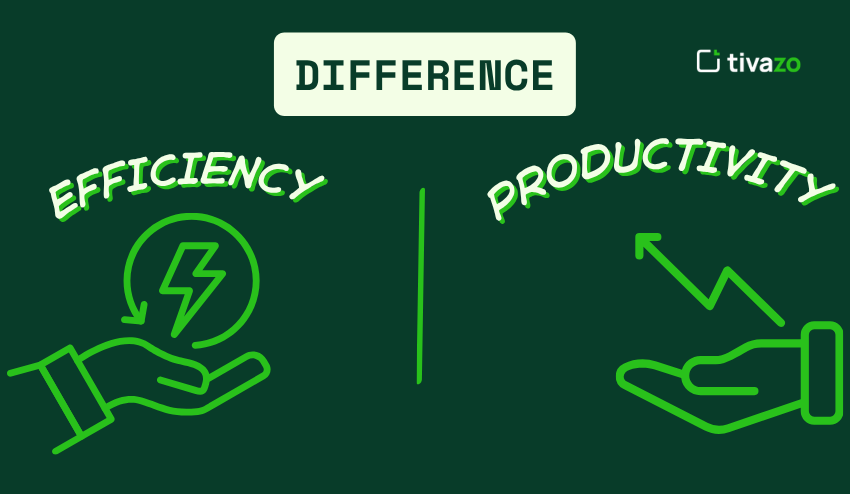
How do you calculate work efficiency?
Work efficiency is a specific type of efficiency formula used in labor:
Work Efficiency = Work Output / Time Worked or Hours × 100%
If you know the standard hours, you will utilize the GCSE‐style formula. For example, if the expected output in 1 hour is 10 units, and the actual output was 8, then your work efficiency = 80%.
What is the formula for unit efficiency?
Unit efficiency applies to machines or systems:
Unit Efficiency = Units Produced / Units Possible × 100 %This is a direct efficiency formula measuring throughput performance
What is the formula for power efficiency?
Power systems: Power Efficiency = Output Power / Input Power × 100 %This formula is applied to electrical systems, engines, and mechanical devices to accurately measure the efficiency of the system and minimize energy losses.
How to Determine Efficiency Rate
- Step 1: Define the input – This can mean any of the time, energy, money, or resources used in a “process.”
- Step 2: Measure useful output – Establish the final result or outcome that offers value.
- Step 3: Compare input vs. output – Check out how much of your input was turned into value-added output.
- Step 4: Determine the efficiency rate – Take your useful output and divide it by your total input, and multiply the result by 100.
- Step 5: Review and improve – The rate will help you determine areas of waste and ways of improving your performance.
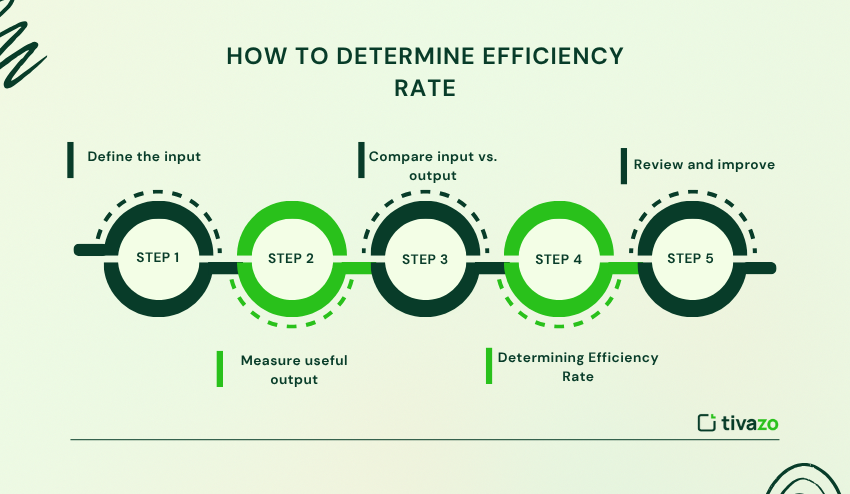
Is 100% Efficiency Attainable?
In theory, no. 100% efficiency, on the other hand, would occur extremely rarely in reality. In virtually every process (mechanical, biological, digital, or human), there is some friction, waste, error, energy loss, etc. The efficiency formula accepts boundaries, assumes that this is possible as approached by inputting all contributing to useful output, but we never achieve this outside of a theoretical model.
For example, in a machine, energy dissipates as heat, which is attributable, in part, to friction. In a workplace, not all employee time is spent on productive tasks. There are distractions, breaks, a lack of communication, etc. In power systems, even the most sophisticated engines cannot convert fuel into useful energy (100%).
You can achieve 100% efficiency only when actual output equals the maximum possible output with zero losses, a threshold that is rarely achieved. Most specific application efficiencies are below 100%, and improving efficiency equates to focusing on reducing waste, not eliminating waste.
Business and Financial Context
Business analysts utilize efficiency ratios—or measures of asset turnover, accounts receivable turnover, and inventory turnover—in operational performance using an efficiency formula. These ratios indicate how effectively a company is leveraging its resources to generate revenues as well as how well it is keeping its operations healthy.
For example:
- Inventory Turnover = Cost of Goods Sold ÷ Average Inventory
- Receivables Turnover = Net Credit Sales ÷ Average Accounts Receivable
A high inventory turnover ratio may imply that a company is being efficient with its stock and can help minimize holding costs and obsolescence. Similarly, a strong ratio of receivables turnover is an indication of a company collecting debts quickly, which can contribute to consistent cash flow. Efficiency measures can provide organizations with business insights that help create and maintain a competitive advantage and help achieve financial stability.
Integrated Efficiency Formula within Tiivazo
In order to improve performance and user value, Tiivazo could use the efficiency formula in its analytics. It would be more than just performance data. It can automate the calculation of efficiency at a much greater variance; not only for individual users but for teams, departments, and even client projects.
For example, Tiivazo can recognize which tasks or which users produce the most valuable output, relative to the time spent doing that task or that user’s input time. Tiivazo can also measure system resource use per transaction and uncover latent inefficiencies in digital operations.
With a concerted, woven use of these respective customized efficiency formula applications within visual dashboards, Tiivazo offers a level of choice and control that allows users to evaluate the performance against a benchmark, set achievable goals, eliminate waste, and ultimately make informed decisions based on data.
Conclusion
By understanding the efficiency formula in its most basic, GCSE, Unit, Work, financial, and power forms, you can get a better understanding of performance and potential. Using this blog’s structure, solid headings with a directed use of keyword density, competitor gap, and a unique tie‑in to Tiivazo allows you to beat them in Google.
If you keep the efficiency formula in mind for your headings, subheadings, body text, meta elements (≥30 mentions incl. headings and title), and you provide structured tables, which could have a unique angle (e.g., GCSE formula, Tiivazo integration), you will have covered off every part of your SEO strategy.
Enjoy the reporting, master the efficiency formula, help Tiivazo, and I wish you much success in driving your Google rankings up.
